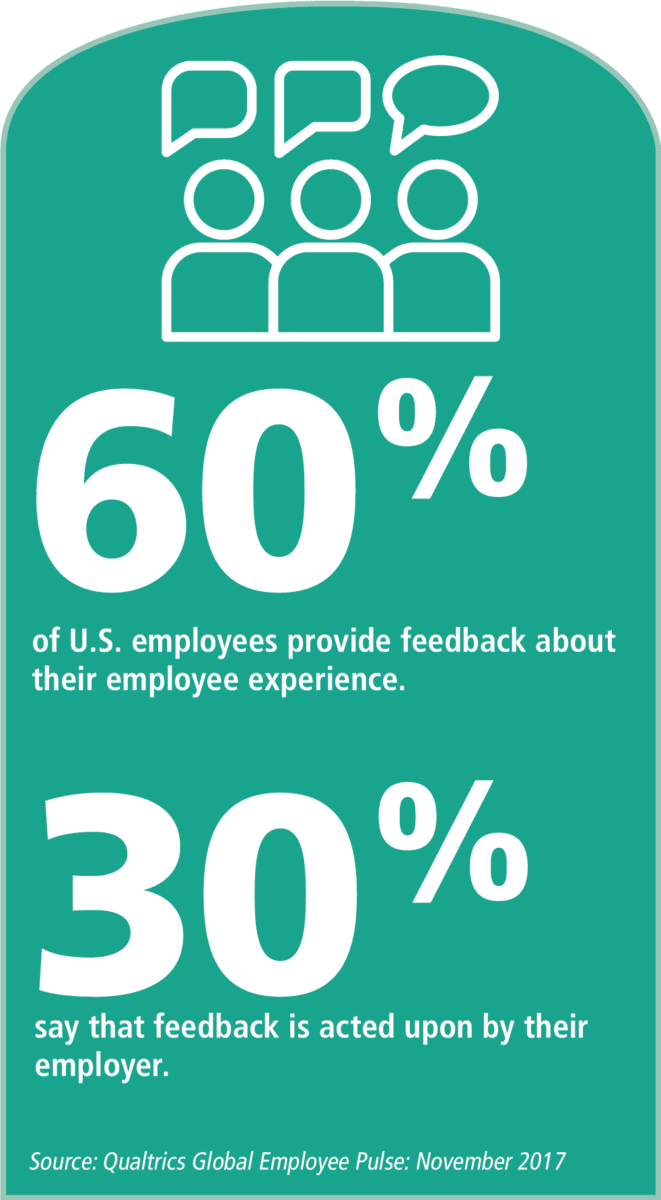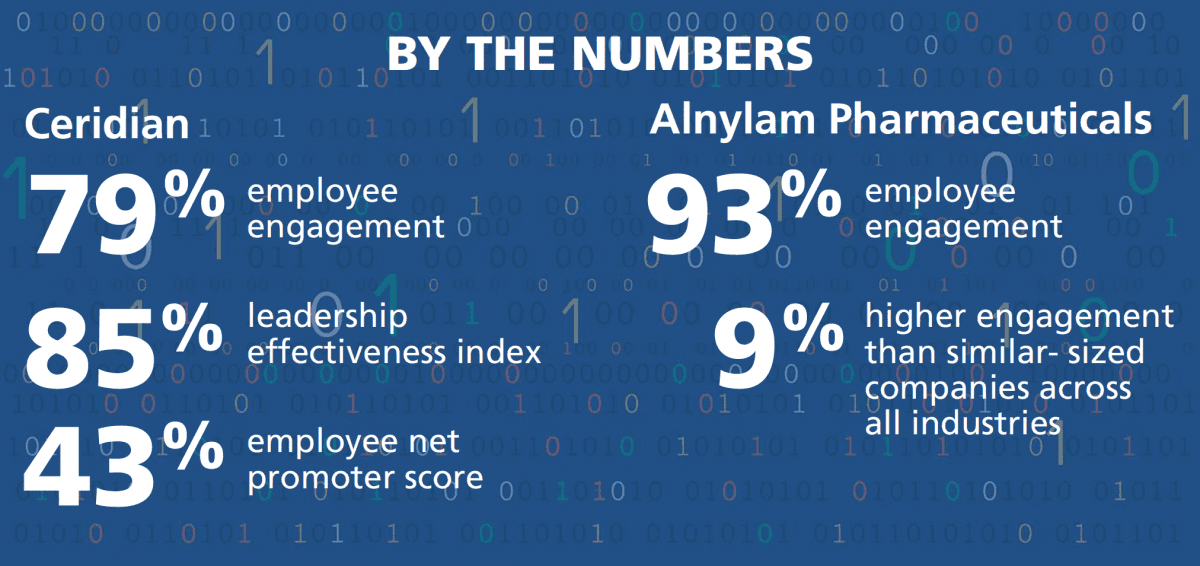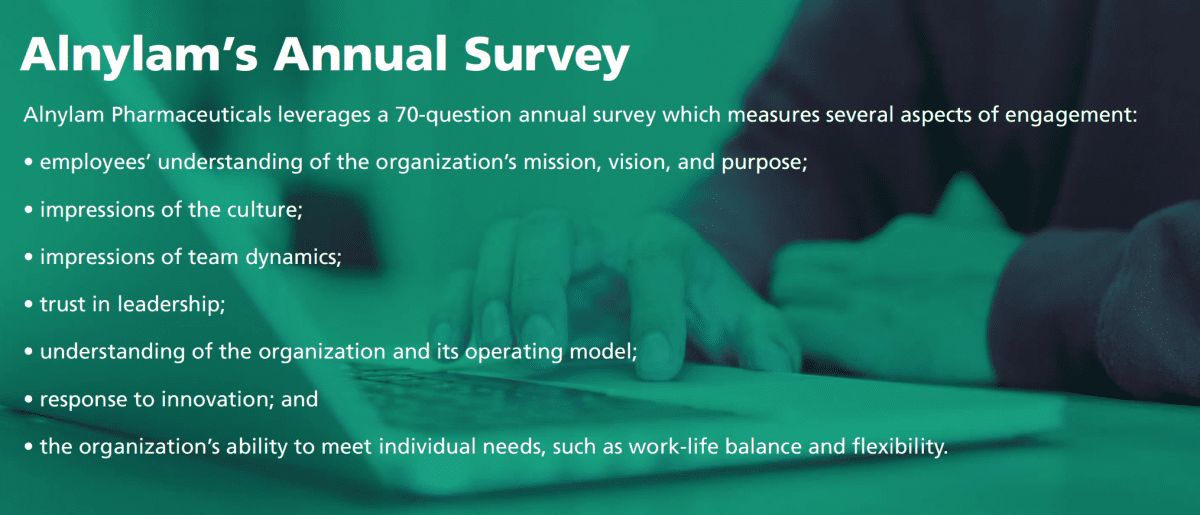Two HR leaders share their innovative strategies that have resulted in industry-leading employee engagement rates.
By Marta Chmielowicz
What motivates talented employees to stay at a company? The answer is complex and multi-dimensional, and often includes factors like opportunities for growth, work with a greater purpose, consistent feedback and recognition, and a schedule that fits their lifestyle. But underlying these elements of a positive work experience is a culture that promotes high employee engagement.
Due to a tightening labor market and competitive global economy, high-performing individuals have an unprecedented amount of freedom in where they choose to work and companies must adapt or get left behind. ISG Director Stacey Cadigan says, “Ultimately, engagement has become deeper than just a workplace initiative. It is embedded in the culture of the organization. Creating an organization where employees feel they have what they need to be successful, are cared about as individuals, and receive continuous feedback and the opportunity to grow needs to be embedded within the organizational culture.”
Alnylam Pharmaceuticals and Ceridian are two organizations working to revamp and modernize their employee engagement strategies. As a result of its efforts, Ceridian has increased its employee engagement by 22 percent over three years to 79 percent today. Likewise, Alnylam Pharmaceuticals has a workforce that is 93 percent engaged.
How have these two companies achieved such positive results?
Survey Often
Creating an effective employee engagement strategy requires an understanding of existing employee attitudes. Annual employee engagement surveys have historically been the norm, with DecisionWise’s 2018 State of Employee Engagement Report indicating that 56 percent of companies leveraged annual surveys in 2018 while only 16 percent utilized more frequent quarterly surveys.
But according to Lisa Sterling, chief people and culture officer at Ceridian, infrequent annual surveys do not necessarily provide an accurate reading of company culture. “We believe that as the world of work has changed significantly, that the traditional employee engagement surveys are just too outdated and archaic,” she explains. “They don’t address information in real time. When you have sites out there like Glassdoor where people can go out and comment on the pros and cons of your organization, measuring that internally once or twice a year is not significant enough. It doesn’t change business results and it doesn’t change behavior.”
In fact, Ceridian has chosen to abandon annual surveys completely. Instead, the company has begun its transition toward real-time, every day evaluations of employee net promoter scores through its Dayforce HCM platform. Once complete, this approach will allow Ceridian’s HR team to consolidate all of its people data into one comprehensive database that can be easily leveraged for more holistic insights by leadership teams.
But the transformation isn’t happening overnight. The company first moved away from annual engagement surveys back in 2016 when it adopted bi-annual surveys, and then quarterly pulse surveys in 2017.
“We began measuring engagement much more in real time with very specific areas of focus based on what we knew was driving behaviors and driving business outcomes,” explains Sterling. By examining areas where engagement was linked to regrettable turnover and low employee net promoter scores, Ceridian was able to identify two key focus areas: workplace experience and leadership effectiveness.
“This year, we’ve moved even further away from that with actual real-time data,” she adds. “And next year, we will be measuring engagement every day as part of our HCM solution.”
In contrast, Alnylam Pharmaceuticals finds value in its annual employee engagement survey as a jumping off point for further discussion about areas of focus. According to Karen Anderson, senior vice president and CHRO, the company has implemented an annual culture survey through Quantum for the past eight years, delivering a wealth of consistent longitudinal data that proves valuable for measuring the impact of specific initiatives overall as well as by leader. For example, the organization asks employees about their understanding of company culture and the operating model, trust in leadership, and initiatives to meet individual needs.
The annual survey is then supplemented with short pulse surveys targeted toward employees who rated the company low in specific areas like work-life balance or communication. The pulse surveys are distributed six months after the initial survey and ask three questions:
- Have you begun to see results in the last six months?
- Do you understand the commitment of your respective senior leader?
- Have you had an opportunity to give input and ideas to improving the culture in your area?
“This gives the employees an open space opportunity to give us comments,” says Anderson. “It helps our leaders see what is moving the needle and what is supporting the group. Or if they think they have made progress but half the group disagrees, that in itself is a good indication to the leader that the diversity in which they’re approaching the problem may not resonate with everyone. It is helping individual leaders who at the core own their engagement and culture.”
Listen to Employees
But Ceridian and Alnylam Pharmaceuticals don’t only rely on engagement survey results -both companies provide employees with opportunities to offer direct feedback.
“Employees have different needs and different requirements to be successful, whether that is work-life balance, career opportunities, mentoring, or other programs,” says Cadigan. “A more bottom-up approach to work engagement where employees can help craft their work experience and increase the fit between the employee and employer will ultimately result in improved performance and higher levels of engagement. Organizations should therefore talk to their people about their goals, understand what employees want, and then figure out how to align employee personal goals with the company’s business objectives.”
Alnylam Pharmaceuticals does this by inviting 15 to 18 individuals each year to participate in a talent board that digs into the results of the employee engagement survey, discusses how to support each segment of the workforce, and develops various proposals for addressing organizational problems. Employees are nominated to participate on the board for a one-year term and are chosen based on their passion, commitment to the organization, and outspoken nature.
Anderson also notes that participation on the talent board presents a coveted opportunity for career growth. The chosen individuals serve as representatives and spokespeople for employees across functions, and get a rare chance to guide policy, test new ideas, and present their ideas to the senior leadership team.

Ceridian has also implemented various strategies to get to the root of employee attitudes. According to Sterling, “The thing that we have found to be so incredibly successful is the philosophy of going to where the action is and listening with intent. I think it’s a missed opportunity when organizations aren’t going down to that lowest paid employee, sitting down next to them in their cubicle, and asking them ‘What can I do to help you? How can I make your work life better?'”
One of the ways that the company engages all levels of the workforce is through regularly scheduled, global town halls where employees can spend time speaking with the CEO. Another opportunity is a global, all-hands meeting where leaders can ask questions, answer questions, and engage with their people.
After this meeting, leadership team members share information and determine the areas where change could have the greatest impact on employee well-being. For example, the event recently resulted in technology improvements to allow greater collaboration across geographically-dispersed teams and a flexible time away from work program that has dramatically improved engagement. These decisions and the thought processes behind them are then communicated throughout all levels of the organization.
This type of approach allows organizations to get a more accurate idea of each employee’s needs, which ISG’s Cadigan believes is especially important in today’s multi-generational workforce. “The millennial generation typically gets credit for prioritizing good work-life balance. Generation X is known for seeking recognition from their leaders. However, managers in organizations need to ensure they are focusing on managing individual differences rather than generational stereotypes. Designing the right strategy for each organization requires a strong understanding of the individual dynamics in the workforce.”
Provide Balance
In addition to providing opportunities for employees to be heard, Alnylam and Ceridian can attest to the importance of delivering work-life balance. “One of the things that we’ve learned is people have a big philosophy around wanting better integration between work and life, and that has been something that consistently came up in our overall engagement conversations and discussions in the past two years,” says Sterling. “One of our goals is to select really smart people and give them the power to do their job and the flexibility to be the best version of themselves at and away from work.”
Ceridian provides this flexibility in its “Take Two” program, started in 2017 to allow any employee to take spend two hours throughout the day taking care of personal matters. While this initiative immediately raised engagement, Ceridian then compounded the effects with an unlimited time away from work program. These initiatives give employees the power to make decisions about how they get their work done and the flexibility they need to support a mindset of independence and personal accountability.
Alnylam Pharmaceuticals has also adopted a similar approach, with policies to support compressed work weeks, remote working, flexible time-off, and “recharge times” where the entire company takes time off to decompress.
“More and more, employees want to control their time and achieve better balance,” Cadigan says. “Whether it is offering more flexible work arrangements or unique wellness programs, supporting a healthy work-life balance has become important for organizations looking to enhance employee engagement.”
















